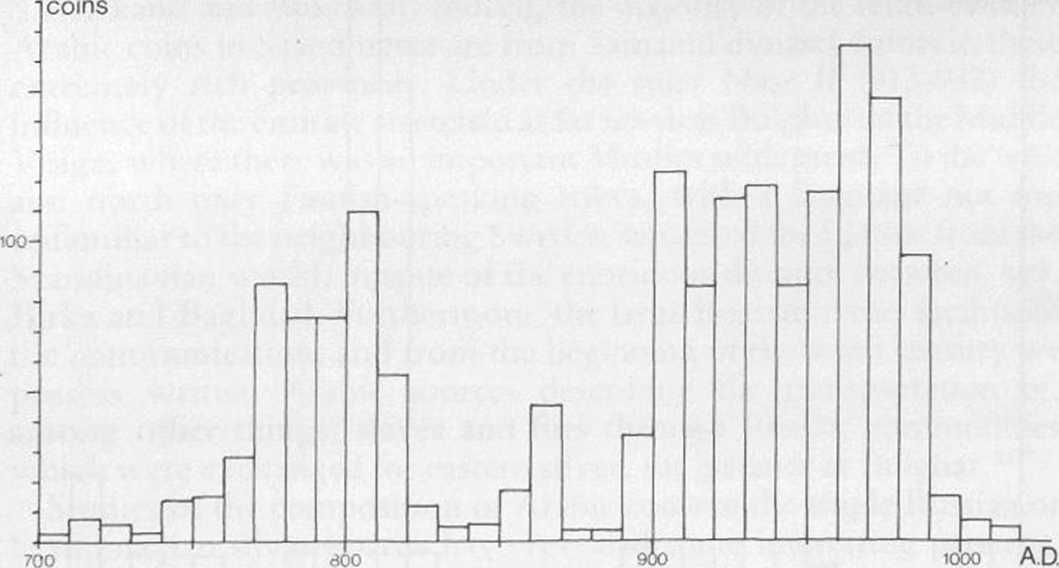80 (129)
154 The Viking Age in Denmark

Figurc 44 Distribution of Arabie coins in a sam ple of north-west Russian silvcr-hoards
ccntury sonie Arabie coins reached western Europę from Scandinavia, found, for instance, in English silver hoards ofthe ‘Norse’ provinces.2fJ
The Kaupang harbour apparently did not survive the late ninth-century decline in silver, and Birka certainly did not live out the drastic mid-tenth-century depression.27 This shows how fragile the Scan-dinavian townships to the north of Denmark were, and also that they functioned mainly as markets for luxuries, first of all of western origin, in cxchange for Arabie and some west European silver too. At Birka a town wali was set up shortly before the site was abandoned in 950-960. The rampart is lying on top of a grave with a coin from about 925 and may reflect an inerease of raiding in the Baltic, corresponding to the tenth-century silver decline (cf. the contemporary town wali of Hedeby). The early tenth-century silver peak is reflectcd in the Birka graves, where 30 Arabie coins are of the period 890 to 930; 20 of these are from 900 to 920, while only three are latcr, from 930 to 950 (Fig. 42). The corresponding western coins are only five in number, but datę from the period 900 to 930 and are parallel to the major Arabie importation. Eight Nordic coins of the tenth century have also been found, all of which were struck at Hedeby, where minting was resumed in the early tenth ccntury after a cessation of about fifty years.

Figurę 45 Distribution of Arabie coins in a sam ple of south-west Russian silver-hoards
As in the ninth ccntury, wc notę a correlation between the periods of International tracie and coin importation from both the east and the west and the size of the silver stock, as established for Denmark. This is not to deny that most of the silver was eastern; from western Europę came morę goods.
The pattern of imported Arabie silver directs our attention to Russia. From there we have a sample of 42 hoards, with Arabie coins covering the whole Viking period from 780 to 1040 without intervals and spread geographically from the Finnish Bay to the old provinces of Kiev and Poltava and, to the east, from the area at Kazan on the middle Volga to the lower Don.28 Fifteen of the finds are from before 900, 17 from the tenth century, and the rest later. The Arabie coins of the sample, from 700 onwards, totalling five thousand, display a elear two-peak distribution writh a deep depression between the periods of intensive import (Figs. 44-6). The first concentration, as in the Birka graves, lies around 800 - in Russia perhaps a little earlier than at Birka. The second, and strongest, peak comes after 890, ending in the tenth century, while very few coins stem from the period 870 to 890. Indeed, after 820 the number of coins is already declining in Russia. To the east, in the Kazan area, the tenth-century depression takes place as early as the second quarter of the century, while in north-west Russia, closer to eastern Scandinavia (and Birka), a morę gradual decline is seen by 950. In the south-west, however, Arabie coins still arrive in relatively large numbers until the last quarter of the tenth century.29
The drastic fluctuations in the flow of Arabie silver into Russia can hardly be explained by shifting intensity of minting in the Islamie world.30 They must be connected with alterations of the tradc patterns and, in the end, of the Arabie demand for, or ability to acquire, those
Wyszukiwarka
Podobne podstrony:
75 (129) 144 The Viking Age in Denmark Figurę 38 Average weight ofthesilver-hoardsofthe period 900 t
43 (292) 80 The Viking Age in Denmark meant primarily for trade, but were used rather as some kind o
57 (213) 108 The Viking Age in Denmark Platę IV. Silvcr and copper dccorated spurs, length about 21
58 (195) 110 The Viking Age in Denmark Platę VI. Sample from late tenth-century silver-hoard at Taru
60 (189) 114 The Viking Age in Denmark Platc X. Ship-sctting and runestonc (on smali mound) at Glave
62 (179) 118 The Viking Age in Denmark Plato XIV. Iron tools from a tenth-ccntury hoard atTjclc, nor
63 (170) 120 The Viking Age in Denmark % Platę XVI Pagc with illustration of an English manuscript f
64 (171) 122 The Viking Age in Denmark Figurc 30 Distribution of wealth in three cemeteries as measu
66 (160) 126 The Viking Age in Denmark have becn fouhd (Figs 32-3).7 They stem from thc same provinc
68 (153) 130 The Viking Age in Denmark two tortoise bucklcs to reprcsent wornen of high standing, th
69 (151) 132 The Viking Age in Denmark heavy cavalry burials, fincr wcapon graves of thc simple type
70 (150) 134 The Viking Age in Denmark cemetcry at Lejre on Sjaelland a dccapitatcd and ticd man was
74 (134) 142 The Viking Age in Denmark 5C~ł silver 800 900 kxx) A.D. Figurę 37 Fluctuations in che r
27 (504) 48 The Viking Age in Denmark Europcan meteorological data for earlier per
29 (466) 52 The Viking Age in Denmark We have already mentioned the expansion of grasses, and it is
30 (454) 54 The Viking Age in Denmark touch, so the political developmcnt we have described in previ
31 (444) 56 The Viking Age in Denmark pig SO- A horse B 50- 50 cattle 50" sheep (Qoat) Figurę 1
32 (433) 58 The Viking Age in Denmark and from a rurąl scttlemcnt, Elisenhof, less than fifty kilome
78 (124) 150 The Viking Age in Denmark Figuro 41 Danish coins, c. 800 to 1035 A.D. (1) = ‘Hcdeby’ co
więcej podobnych podstron